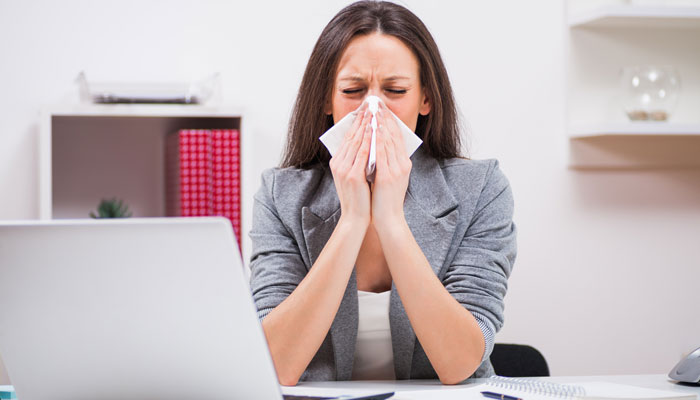So you get free lunch at work, the best coffee you’ve ever drunk, tickets to big cricket matches and monthly bowling nights. That should leave you smiling, content and raring to go. Unfortunately though, the thoughtful perks notwithstanding, you wake up sniffling with a sore head and itchy eyes. It gets worse as the day progresses and as you down antihistamines you wonder why you feel so ill. The cause might take you by surprise. Did you, for instance, know that one in every six people who suffer from allergies does so because of the presence of fungi and bacteria in the workplace air ducting system, according to Total Health and Better Health magazine?
Or that under the right conditions 33 million mould plants can grow in your AC system in a 12 hour period? That female mites can lay 25 to 50 eggs, with a new generation produced every three weeks, with each mite producing about 20 waste particles every day? If you do your math, that’s 42,000 dust mites per ounce of dust you breathe in from un-vacuumed carpets at work. Any surprises then that the World Health Organization estimates that one in three workers worldwide may well be toiling away in workplaces that are making them sick.
Sick building syndrome, or “office sickness” is a real problem, that is on the rise. Read on to know more about the causes of sick building syndrome.
A new survey by US-based Blumberg Capital Partners reveals that the office environment—from the temperature of the air conditioning to the cleanliness of the pantry—can have a significant impact on the wellbeing, health and productivity of employees. In fact, the survey goes so far as to say that a clean, comfortable workplace might actually deter employees form quitting, never mind its overbearing secretaries and penny pinching accountants. On the other hand, 17 percent of the survey respondents reported quitting a company because they hated the building’s condition or amenities.
Forty seven percent of those surveyed thought their offices were too hot or too cold because of poor air conditioning and ventilating systems; In fact, extreme office temperatures often lead to problems such as fatigue and headaches. And nearly one third complained of under-stocked rest rooms (the soap dispenser stayed empty, the napkin stack never got replaced and the toilet paper remained elusive). Another group griped about the outdated furniture and décor (28 percent) while unexplained odours and foul air bothered 21 percent and rodents and leaky ceilings and windows 21 percent of those surveyed.
While similar survey haven’t been done here, it’s unlikely to be every different. Rajani Rohatgi, Administration Manager with a multinational says the problem is widespread. “Undoubtedly, offices can make people sick. If the employees of Levi Strauss, US, BP Amoco and even the Environmental protection Agency in the US have complained of sick-building-related illnesses, the situation here is like a Pandora’s Box, much worse in fact.”
The culprit is a brewing cauldron of largely undetected dangers: From carbon monoxide and other contaminants sucked into a building when air-intake vents overhang exhaust-filled loading docks and parking garages, to the volatile organic chemicals (VOCs) seeping out of building materials, furniture, office equipment, carpet, paint, and pesticides, to the moulds and bacteria funnelled through muck-filled heating, ventilation and cooling systems (HVACs). Even the smoke from those puffing away at entrances gets sucked back into the building because of the suction from revolving doors or what engineers call “the stack effect”.
What compounds matters is that the working day in booming India lasts longer than every before, and the journey to and from the office is no better on roads where cars, buses, autos and trucks spew noxious smoke. Rohini Joshipura, 32, developed asthma and allergies after four years as an account executive in a Mumbai ad agency. “My problems started when we moved to a new office where we couldn’t even crack open a window. The doctor said my allergies were due to the poor indoor air quality,” she says. While this may not matter for those with robust immunity, it can cause relatively mild problems from headaches, nausea, dizziness, short-term memory loss, irritability, and itchy eyes and throats to possible damage to the nervous and respiratory systems in up to 30 percent of the office population, says respiratory disorder specialist, Dr. Reena Malhotra. She adds that the doubling of asthma rates since 1980 have much to do with poor indoor air. What’s even more scary is that the pollutant levels indoors can be two to five times, in some cases even 100 times, more concentrated that outdoors.
Stagnant office air can circulate the residue of as many as 350 VOCs mainly emitted by building material, furnishing and office machines. Malhotra says that most office paints contain solvents that can cause everything from eye, nose, and throat irritation to digestive and central nervous system damage. Carpeting may contain chemicals that give off the carcinogen dioxin. Rohatgi points out that most furniture is made of particle board bonded with resins made with carcinogen-containing formaldehyde. “This isn’t even considering the pesticides and cleaning products that are used to swab the table tops, floors and wash rooms, and all the chemicals that can get discharged into the air,” he says wryly.
Undoubtedly, sick-building-related symptoms are on the rise. Malhotra says there’s been a quantum jump in the number of people suffering from allergies and breathing problems, and it can’t be all blamed on outdoor pollution. “Chemicals are being introduced into the office environment through synthetic products and ventilation systems haven’t been able to keep pace by delivering fresh air,” she says.
The fact is, air conditioning systems require regular maintenance. Rohatgi says that while most companies do have servicing contracts for their units, the quality of upkeep is often not up to the mark. Equally disturbing is the finding that general lackadaisical attitude towards standards and fittings means that up to 90 percent of residential ductwork is the wrong size. “Leakages in the duct system can be hazardous to your health,” warns Rohatgi.
She advises company administrators and home owners to identify brewing problems such as excessive dust, dirt lines on carpet edges, dry air or static shocks, lingering or musty odours; high utility or repair bills, dirt or sweating on AC units, and having to constantly turn the thermostat up or down.
It’s no longer easy to dismiss sick-building complaints as the psychosomatic ranting of whingeing, lazy workers. In fact Malhotra goes so far as to say what we’re seeing in India to date is just the tip of the proverbial iceberg, “a kind of chemical HIV that’ll spread like wildfire.” As Joshipura says, “I want to be in a workplace where I feel good and where I can be productive. I’d like to see the day when I can walk around an office and refuse the job if the environment is lousy.” After all, employees don’t just want pay cheques, they deserve clean office conditions too.


